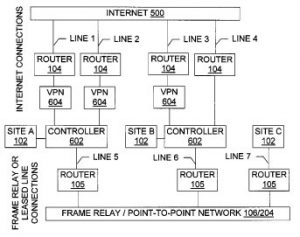On November 1st, a panel of administrative patent judges (APJs) at the Patent Trial and Appeal Board (PTAB) issued a final written decision which found that 11 claims of a networking patent held by Salt Lake City, UT-based wide area network (WAN) developer FatPipe Networks as being anticipated and obvious in light of prior art. A press release on the news from FatPipe, however, notes that the PTAB panel did not invalidate “a signature claim” of the patent covering a method for load balancing over disparate networks.
 The final written decision issued by the APJ panel at the PTAB invalidated claims 4, 5 and 7-15 of U.S. Patent No. 6775235, titled Tools and Techniques for Directing Packets over Disparate Networks. Claim 1 of this patent, issued in August 2004, covers a controller which controls access to multiple independent disparate networks in a parallel network configuration, the networks including a private network and one based on the Internet, in a way which provides data load balancing for greater network reliability and security.
The final written decision issued by the APJ panel at the PTAB invalidated claims 4, 5 and 7-15 of U.S. Patent No. 6775235, titled Tools and Techniques for Directing Packets over Disparate Networks. Claim 1 of this patent, issued in August 2004, covers a controller which controls access to multiple independent disparate networks in a parallel network configuration, the networks including a private network and one based on the Internet, in a way which provides data load balancing for greater network reliability and security.
Petitioner Talari Networks, a San Jose, CA-based provider of software defined wide area network (SD-WAN) solutions, submitted two pieces of prior art to challenge the validity of the ‘235 patent claims. One was U.S. Patent No. 6628617, titled Technique for Internetworking Traffic on Connectionless and Connection-Oriented Networks and issued in September 2003. It claims a method of processing datagrams transmitted to a gateway from a source via a connectionless network so that the datagrams can be transmitted to a destination via a connection-oriented network in such a way that does not require a large buffer while a datagram pathway is being configured. The other piece of prior art submitted was a 1997 publication titled Data and Computer Communications authored by computer science textbook writer Dr. William Stallings. Petitioner Talari argued that all challenged claims were invalid in light of the ‘617 (“Karol”) patent on grounds of 35 U.S.C. § 102 for novelty and 35 U.S.C. § 103 for obviousness. Additionally, challenged claims were rendered obvious based on the combination of Karol and Stallings.
Although petitioner Talari Networks was successful in invalidating most challenged claims based on the prior art presented, the entity didn’t manage to invalidate claim 19 which FatPipe considers to be “a signature claim.” Claim 19 of the ‘235 patent reads:
“A method for combining connections for access to parallel networks, the method comprising the steps of: sending a packet to a site interface of a controller, the controller comprising the site interface which receives packets, at least two network interfaces to parallel networks, and a packet path selector which selects between the network interfaces on a per-session basis to promote load-balancing; and forwarding the packet-through the network interface selected byte packet path selector; wherein the step of sending a packet to the controller site interface is repeated as multiple packets are sent, and the controller sends different packets of a given message to different parallel networks.”
“Having gone through the most rigorous evaluation, we now have a the ability to protect the company’s invention on WAN load balancing for VoIP, VPN and data traffic for corporate networks,” said Dr. Ragula Bhaskar, CEO of FatPipe Networks, in the press release. Dr. Bhaskar said that survival of claim 19 at the PTAB “elevat[es] it to a super claim status.” Including the ‘235 patent, FatPipe holds a portfolio of 11 patent assets and more than 180 technological claims covering “the full spectrum of hybrid WAN and SD-WAN technology.”
In the final written decision at the PTAB, the panel noted that claim 19 was similar to claim 5 in that they’re both directed to combining connections for access to parallel networks. The panel was not persuaded by the petitioner’s argument that the Karol prior art reference discloses the sending of different packets of a given message to different parallel networks. “Karol does not describe any logical grouping of datagrams into a message,” the panel found, noting that the patent uses the term “datagram” interchangeably with the terms “message” and “packet.” Thus, it was not clear that Karol contemplated the same type of message in claim 19 of the FatPipe patent, a finding which rendered Talari’s obviousness and anticipation arguments moot.

![[IPWatchdog Logo]](https://ipwatchdog.com/wp-content/themes/IPWatchdog%20-%202023/assets/images/temp/logo-small@2x.png)


![[Advertisement]](https://ipwatchdog.com/wp-content/uploads/2024/04/UnitedLex-May-2-2024-sidebar-700x500-1.jpg)
![[Advertisement]](https://ipwatchdog.com/wp-content/uploads/2024/04/Artificial-Intelligence-2024-REPLAY-sidebar-700x500-corrected.jpg)
![[Advertisement]](https://ipwatchdog.com/wp-content/uploads/2024/04/Patent-Litigation-Masters-2024-sidebar-700x500-1.jpg)

![[Advertisement]](https://ipwatchdog.com/wp-content/uploads/2021/12/WEBINAR-336-x-280-px.png)
![[Advertisement]](https://ipwatchdog.com/wp-content/uploads/2021/12/2021-Patent-Practice-on-Demand-recorded-Feb-2021-336-x-280.jpg)
![[Advertisement]](https://ipwatchdog.com/wp-content/uploads/2021/12/Ad-4-The-Invent-Patent-System™.png)






Join the Discussion
4 comments so far.
Benny
December 3, 2017 03:23 amYeah, its pretty bad when an examiner grants a “signature claim” with a glaring typo suggesting that he neither read nor understood it.
Darrin
December 2, 2017 02:40 pmI highly doubt that this “glaring typo” would result in indefiniteness, whether under In re Packard or Nautilus tests. (The correct wording is sprinkled throughout the claims.) Plus, claim construction is a necessary stage of IPR and definiteness is interwoven with claim construction. If the PTAB considered claim 19 too indefinite to construe, then the challenge would not have been instituted for claim 19.
I like the patentee publicity team emphasizing that “signature claim” survived the PTAB.
Heidenscherser
December 1, 2017 09:38 amYeah, it’s pretty bad when your “signature claim” has a glaring typo.
patentreformbad
December 1, 2017 09:24 amGood luck getting that claim through indefiniteness hearings. In a 30 second reading, there is at least one clear typo:
“forwarding the packet-through the network interface
selected byte packet path selector; ”
the probably mean “selected BY THE packet path selector,” but since byte is a term of the art, it makes it a a bit more complicated. Usually if something has clear mistakes that jump out in a 30 second reading, they are likely to be riddled with other slopiness too.